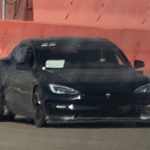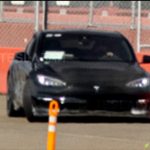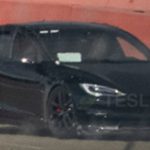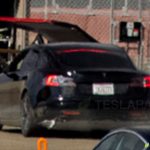
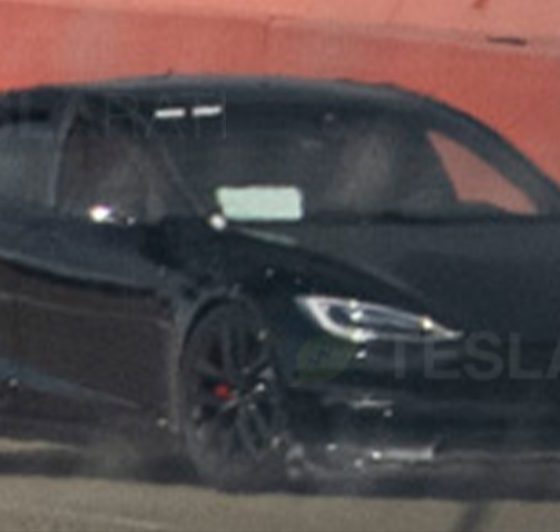
News
Tesla Model S “Refresh” spied track testing
New photos from the Tesla Fremont Factory obtained by Teslarati show the new Refreshed Tesla Model S and its new features, confirming the long-time speculation of whether the company’s flagship sedan would be updated nine years after its initial release. After the Plaid Model S was announced in 2019, slight cosmetic modifications were added to the car to increase aerodynamic performance in a track setting. Some of these new features included a wider body, a rear diffuser, and a spoiler. Tesla has made several changes to the Refreshed Model S, as seen in the photos below. The vehicle was spotted at both the Fremont Test Track and on public roads when the photographs were taken.
For those who are unfamiliar, Tesla operates its own test track behind the Fremont factory for its vehicles. In 2013, three years after Tesla’s purchase of the Fremont factory from GM, the electric automaker bought the 35-acre property that included the test track from the Union Pacific Railroad. It is located adjacent to the Fremont factory, so Tesla can take cars that need to be tested to the track within a few minutes. In the past, Tesla has tested vehicles like the Model Y and the 2020 Roadster at the track prior to their release, indicating that the new Model S that was spotted could be on its way to the company’s Design Studio shortly.
Initial rumors of the Model S refresh emerged in late 2020 after several updates to the Model 3 and Model Y vehicles. While the Model Y underwent several minor updates, like a new center console, new door paneling, and a heated steering wheel in China, the Model 3 was the subject of more noticeable cosmetic revisions. The mass-market sedan from Tesla was equipped with a full chrome delete kit that now comes standard, a new center console design, new headlights, double-paned glass, a powered trunk, and other interior revisions.
On the other hand, the Model S has only undergone one true cosmetic revision since its initial release nearly nine years ago: the removal of the nosecone. Since the vehicle has gone so many years without a real update or any major changes to its aesthetic qualities, Tesla may have decided it was time to “refresh” the car.
Now, photographs of the new Model S have been captured, showing a wider body, revised fog lights, new wheels, and several other cosmetic revisions.
A few of the more notable changes are a new front diffuser, a part that became standard with the newly-designed Plaid Model S. A diffuser displaces air underneath the vehicle’s body, increasing aerodynamic performance and making the flow of air more efficient during travel. Additionally, the front fascia has also been revised slightly. This is the second revision Tesla has made to this portion of the Model S since its release. The new design includes a larger central air intake vent for improved airflow and ventilation to the battery pack. This eliminates the possibility of overheating and improves battery lifetime and performance.
- The Model S in this photograph shows the revised front fascia, new fog light design, a wider body and new wheels. Photo: Teslarati
- A second photo shows a head-on view of the Model S spotted at Fremont. Photo: Teslarati
- Tesla has placed new wheels on the Model S in this photo, reminiscent of the Arachnid wheels that were included in the referral program. Photo: Teslarati
One of the more interesting and speculative details of the new Model S is that there is no touchscreen protruding from the top of the dash. The Model 3 and Model Y center dash screen can be seen from the outside of the vehicle when looking through the windshield. There is no evidence that Tesla is adopting the 3 and Y center touchscreen design for the Model S refresh. We are currently not aware of any modifications to the vertical touchscreen that has been standard on the Model S and Model X.
The fog lights located on the bottom of the front lip have also been modified, bringing a slightly new look to the lower lights. Additionally, new wheels appear to be on the Model S, and they look to be a revised version of the Arachnid wheels that Tesla included as a Referral Program reward back in 2016. Neither the 19″ Tempest Wheels nor the 21″ Sonic Carbon Twin Turbine Wheels that are available with the Plaid Model S matches the wheels that were equipped on the vehicle that was spotted at the Fremont Factory. This appears to confirm Tesla may also be releasing a new wheel design that will be included with the Refreshed Model S design.
It seems the refreshed Model S has adopted more features that are going to be included on the Plaid Model S, due to be released in late 2021. A wider fender design is paired with new, wider wheels. These modifications were first noticed on the Plaid Model S that was spotted running spirited laps at the Nürburgring in Germany in 2019.
Photo: Teslarati
Another interesting note is the side repeater cameras have been adjusted onto the new fenders, but only slightly. It appears Tesla has moved it forward toward the wheel well. This could be to increase visibility when the cameras are activated.
The final noticeable external revision is a new rear bumper design that is more robust than the original Model S design. This could be indicative that the black Model S in the photos we shared could be the Plaid Model S, as it also has a wider rear bumper. However, it does not have a rear diffuser installed underneath, meaning it could just be a refreshed design.
- Photo: Teslarati
- Photo: Teslarati
- Photo: Teslarati
Tesla is holding its Q4 2020 Earnings Call on Wednesday and many enthusiasts believe the company will announce either a refresh to the Model S, or will indicate the Plaid Model S will be on its way soon. With the several external modifications that have been spotted thanks to the pictures above, we know that Tesla is working on a revised design for its flagship sedan. While no details are known about the interior as of yet, details will be shared as they are found.
The Kilowatts spotted some more photos of the unique Model S at Fremont, providing some additional perspective on what changes Tesla made to its flagship sedan.

News
Tesla starts showing how FSD will change lives in Europe
Local officials tested the system on narrow country roads and were impressed by FSD’s smooth, human-like driving, with some calling the service a game-changer for everyday life in areas that are far from urban centers.

Tesla has launched Europe’s first public shuttle service using Full Self-Driving (Supervised) in the rural Eifelkreis Bitburg-Prüm region of Germany, demonstrating how the technology can restore independence and mobility for people who struggle with limited transport options.
Local officials tested the system on narrow country roads and were impressed by FSD’s smooth, human-like driving, with some calling the service a game-changer for everyday life in areas that are far from urban centers.
Officials see real impact on rural residents
Arzfeld Mayor Johannes Kuhl and District Administrator Andreas Kruppert personally tested the Tesla shuttle service. This allowed them to see just how well FSD navigated winding lanes and rural roads confidently. Kruppert said, “Autonomous driving sounds like science fiction to many, but we simply see here that it works totally well in rural regions too.” Kuhl, for his part, also noted that FSD “feels like a very experienced driver.”
The pilot complements the area’s “Citizen Bus” program, which provides on-demand rides for elderly residents who can no longer drive themselves. Tesla Europe shared a video of a demonstration of the service, highlighting how FSD gives people their freedom back, even in places where public transport is not as prevalent.
What the Ministry for Economic Affairs and Transport says
Rhineland-Palatinate’s Minister Daniela Schmitt supported the project, praising the collaboration that made this “first of its kind in Europe” possible. As per the ministry, the rural rollout for the service shows FSD’s potential beyond major cities, and it delivers tangible benefits like grocery runs, doctor visits, and social connections for isolated residents.
“Reliable and flexible mobility is especially vital in rural areas. With the launch of a shuttle service using self-driving vehicles (FSD supervised) by Tesla in the Eifelkreis Bitburg-Prüm, an innovative pilot project is now getting underway that complements local community bus services. It is the first project of its kind in Europe.
“The result is a real gain for rural mobility: greater accessibility, more flexibility and tangible benefits for everyday life. A strong signal for innovation, cooperation and future-oriented mobility beyond urban centers,” the ministry wrote in a LinkedIn post.
News
Tesla China quietly posts Robotaxi-related job listing
Tesla China is currently seeking a Low Voltage Electrical Engineer to work on circuit board design for the company’s autonomous vehicles.

Tesla has posted a new job listing in Shanghai explicitly tied to its Robotaxi program, fueling speculation that the company is preparing to launch its dedicated autonomous ride-hailing service in China.
As noted in the listing, Tesla China is currently seeking a Low Voltage Electrical Engineer to work on circuit board design for the company’s autonomous vehicles.
Robotaxi-specific role
The listing, which was shared on social media platform X by industry watcher @tslaming, suggested that Tesla China is looking to fill the role urgently. The job listing itself specifically mentions that the person hired for the role will be working on the Low Voltage Hardware team, which would design the circuit boards that would serve as the nervous system of the Robotaxi.
Key tasks for the role, as indicated in the job listing, include collaboration with PCB layout, firmware, mechanical, program management, and validation teams, among other responsibilities. The role is based in Shanghai.
China Robotaxi launch
China represents a massive potential market for robotaxis, with its dense urban centers and supportive policies in select cities. Tesla has limited permission to roll out FSD in the country, though despite this, its vehicles have been hailed as among the best in the market when it comes to autonomous features. So far, at least, it appears that China supports Tesla’s FSD and Robotaxi rollout.
This was hinted at in November, when Tesla brought the Cybercab to the 8th China International Import Expo (CIIE) in Shanghai, marking the first time that the autonomous two-seater was brought to the Asia-Pacific region. The vehicle, despite not having a release date in China, received a significant amount of interest among the event’s attendees.
Elon Musk
Elon Musk and Tesla AI Director share insights after empty driver seat Robotaxi rides
The executives’ unoccupied tests hint at the rapid progress of Tesla’s unsupervised Robotaxi efforts.

Tesla CEO Elon Musk and AI Director Ashok Elluswamy celebrated Christmas Eve by sharing personal experiences with Robotaxi vehicles that had no safety monitor or occupant in the driver’s seat. Musk described the system’s “perfect driving” around Austin, while Elluswamy posted video from the back seat, calling it “an amazing experience.”
The executives’ unoccupied tests hint at the rapid progress of Tesla’s unsupervised Robotaxi efforts.
Elon and Ashok’s firsthand Robotaxi insights
Prior to Musk and the Tesla AI Director’s posts, sightings of unmanned Teslas navigating public roads were widely shared on social media. One such vehicle was spotted in Austin, Texas, which Elon Musk acknowleged by stating that “Testing is underway with no occupants in the car.”
Based on his Christmas Eve post, Musk seemed to have tested an unmanned Tesla himself. “A Tesla with no safety monitor in the car and me sitting in the passenger seat took me all around Austin on Sunday with perfect driving,” Musk wrote in his post.
Elluswamy responded with a 2-minute video showing himself in the rear of an unmanned Tesla. The video featured the vehicle’s empty front seats, as well as its smooth handling through real-world traffic. He captioned his video with the words, “It’s an amazing experience!”
Towards Unsupervised operations
During an xAI Hackathon earlier this month, Elon Musk mentioned that Tesla owed be removing Safety Monitors from its Robotaxis in Austin in just three weeks. “Unsupervised is pretty much solved at this point. So there will be Tesla Robotaxis operating in Austin with no one in them. Not even anyone in the passenger seat in about three weeks,” he said. Musk echoed similar estimates at the 2025 Annual Shareholder Meeting and the Q3 2025 earnings call.
Considering the insights that were posted Musk and Elluswamy, it does appear that Tesla is working hard towards operating its Robotaxis with no safety monitors. This is quite impressive considering that the service was launched just earlier this year.
